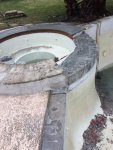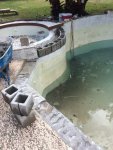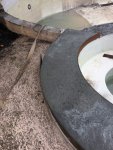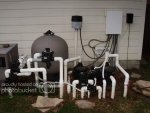If the air line ties into the jets, that's what I would suspect for the leak.
If you can plug the jets and put about 10 psi on the lines, you should be able to verify if the lines are leaking.
If you use air, you should be able to hear bubbles by listening to the deck or coping to locate the leak. It should be really obvious.
The air line typically ties into the top of the spa jet body.
So, I suspect that that's what got damaged during the remodel.
Plug the jets and the return line and remove the blower.
Pressurize with air to about 5 psi where the blower was connected, then listen to the coping above each jet and I suspect that you will hear the leak.
Do you have a picture of the damaged concrete before they restored it?
Did they drill into the old concrete to try to install rebar?
Did you check the damaged concrete to see if they went into the plumbing?
Do you have a close up picture of the return jet or do you know the model number of the return jet assembly?
If you can plug the jets and put about 10 psi on the lines, you should be able to verify if the lines are leaking.
If you use air, you should be able to hear bubbles by listening to the deck or coping to locate the leak. It should be really obvious.
The air line typically ties into the top of the spa jet body.
So, I suspect that that's what got damaged during the remodel.
Plug the jets and the return line and remove the blower.
Pressurize with air to about 5 psi where the blower was connected, then listen to the coping above each jet and I suspect that you will hear the leak.
Do you have a picture of the damaged concrete before they restored it?
Did they drill into the old concrete to try to install rebar?
Did you check the damaged concrete to see if they went into the plumbing?
Do you have a close up picture of the return jet or do you know the model number of the return jet assembly?





